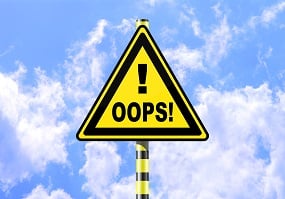Design Fails that Cause Unintentional Consquences

Recently, a sign on the side of the rode caught my eye. It said:
NO SERVICE
Job Too Big
Or Too Small!
Although the message was short and to the point, I couldn’t help but wonder why the owner didn’t put more thought into the layout – obviously NO SERVICE was not the point he intended to convey.
Most people naturally read from top to bottom, from left to right and from big to small. As I was buzzing by the sign at 35 mph, I had to chuckle at the NO SERVICE emphasis. Sure, he hooked me but not in the way he planned.
Three seconds is all you get in advertising, so you have to make a bold, clear statement – FAST. This is an extreme example, but I notice similar design barriers in communications almost every day. The purpose of design is to help make the sale, not hinder it. The best designs are aesthetically pleasing, easily readable and simple to follow. They orient phrases in the direction in which people read them, and they place emphasis on the most relevant part of the message.
Another common mistake is font size and color. Small type decreases readability, which in turn, dilutes response. I recently edited a sales letter written for a senior audience. The original letter was set in Times New Roman size 7.5. How many 67-year-olds enjoy reading 7.5 point font? Not many. Likewise, many designers set a colored body copy font against a shaded background – such as white font against a taupe background or blue font against a black background. When contrast goes down, so does readability and response. If font size is very large (i.e. headline) or the word volume is limited (i.e. callout box), you can get away with reversed copy. But avoid it in body copy whenever possible.
Response is best when readability is best. Here are three readability rules of thumb to help you hook your reader in three seconds or less:
- Use Readable Font Type. Serif fonts (that have “feet”) such as Times New Roman or Georgia have the best reading comprehension in printed pieces. Sans serif fonts such as Veranda are best online. Selling-savvy marketers use colorful, eye-catching fonts in their large headlines (larger size increases readability) to accomplish the brand “look” and revert to a black serif font in the body copy to maximize comprehension and response in their printed marketing pieces.
- Place emphasis in the right places. Remember, we’re not selling art. We are selling products and services. Headlines, offers and calls to action need proper emphasis to be effective.
- Beware of Reverse Type in Body Copy. Reversed copy (lighter letters on a black or colored background) should never be used for body copy. Statistics show anytime the font color varies from black, reading comprehension takes a dive. Black copy on a white background yields optimal comprehension and has been proven to increase response rates by 33 percent when compared with the same copy in white against a black background.
